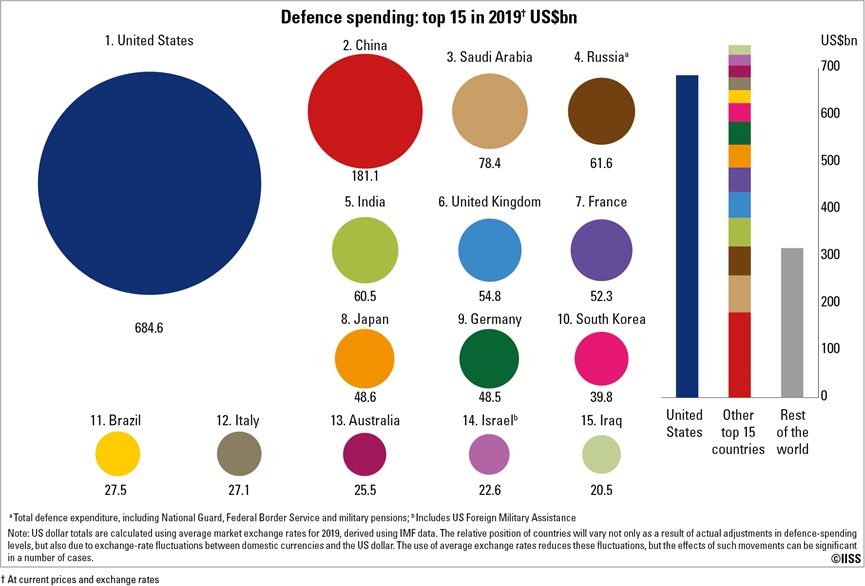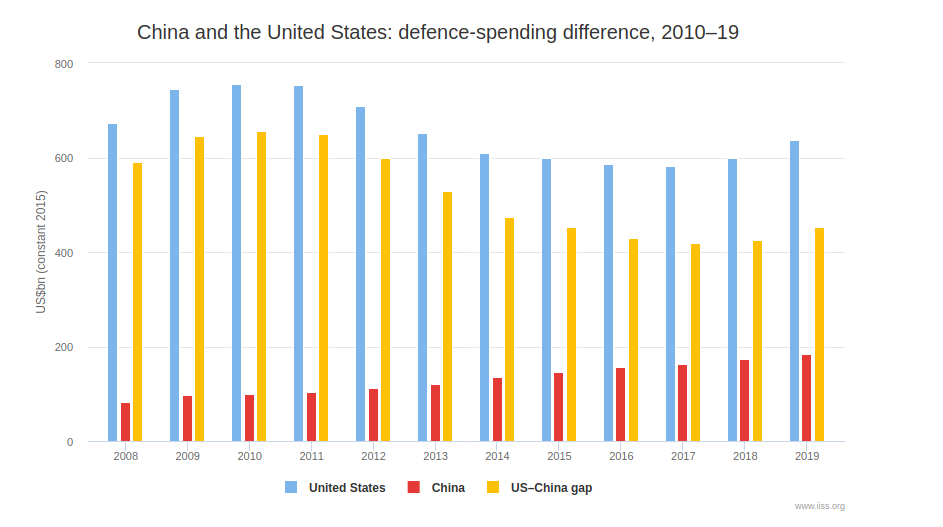IISS data shows that in 2019 the United States, China, Saudi Arabia, Russia and India retained their positions as the world's top defence spenders. Indeed, the only movement in the top 15 saw Italy and Australia swap places, with Italy taking the 12th position and Australia the 13th (Figure 1).
The lack of change in the top 15 reflects an interesting underlying trend, in that the US has if anything just restated its spending dominance. In 2019, global defence spending rose by 4.0% in real terms over 2018 figures, but spending in the US grew by 6.6%. China's spending also rose by 6.6% over 2018 data, but the trajectory of the two states' defence spending is diverging. The budget increase in the US was the largest in ten years, and spending has increased year-on-year since US President Donald Trump took office. While spending is still rising in China, the pace of growth is decelerating, in line with Beijing's relative economic slowdown. This divergence in trajectories means that the spending gap between the two countries, which had narrowed since 2010, has since 2018 increased once more (Figure 2). It remains to be seen, however, if this trend will continue given Washington's plans for a more limited defence-spending increase in FY2021.
Examining the data, it is also apparent that while Washington may be reasserting its global defence-spending dominance, it is simultaneously reducing its financial assistance to allies' defence budgets. This has been exemplified most notably in the reductions to Foreign Military Financing programmes and to the European Deterrence Initiative.
Trends in defence-investment spending
Both China and the US devote significant sums to research and development (R&D) and procurement ('defence investments'), but perhaps unsurprisingly, given the disparity in sums they allocate to defence, the US spends almost three times as much as China (US$201 billion and US$74.4bn respectively, in current dollars). This meant that in 2019 US defence investments alone were larger than China's total defence budget. Meanwhile, Russia's State Defence Order for 2020 has been announced at 1,500 trillion roubles (US$21.7bn). This would place Russia in third position globally for defence-investment spending, but with outlays almost ten times smaller than that of the US.
Data on defence investments in the IISS Military Balance+ online database also shows that the US dedicated a significantly higher proportion of its defence budget to procurement and R&D than its NATO allies. European countries are increasing their defence investments as a share of their total spending - for those countries with available data, funds rose from 19.8% in 2018 to 23.1% in 2019 - but the equivalent category reached 29% in the US. The United States' defence investments were thus worth around four times as much as European states' combined. For smaller countries in Europe, as in other regions, the proportion of investments in the total budget at times appears quite high, but this is because one major acquisition can spike the procurement outlays significantly, albeit only for a limited time span.
Although China lags behind the US in terms of its overall spending on defence investments, it dominates the Asia region. On its own, China accounted for almost 60% of defence investments in Asia in 2019. When placed in the regional context, the scale of China's investments are such that including its numbers means that the average share of defence investment in total Asian budgets reached 30.9% in 2019. Excluding China, this figure falls back to 23.4%, broadly in line with the figure in Europe. Moreover, this proportion has remained fairly consistent over time, putting a dent in the notion that Asia would be engaged in an 'arms race' - one would observe an increasing emphasis on equipment purchases if this were the case. Defence investments increased nonetheless in some countries where the threat perception from China is growing, such as in South Korea (31% in 2018, 32% in 2019), Japan (17% in 2018, 22% in 2019) and Australia (20% in 2018, 24% in 2019).
Comment: Actually, it seems that Japan and South Korea see the US as the "major threat" to global security.
Overall, despite defence-spending growth in other areas of the globe, the US still outstrips by far defence outlays in other countries - both rivals and allies alike - and has accelerated the pace to remain largely ahead. Relatedly, the United States' massive investments in defence procurement and R&D still provide it with a technological and military capability advance compared to the rest of the world.
Methodology note
The IISS Military Balance+ database provides data on defence investments for four regions - Asia, Europe, Latin America and North America. Obtaining reliable but also comparable data across countries and over time is a challenge, given that not all states have the same understanding of what this category of expenditure should include. For example, in Military Balance+, 'defence investment' aggregates defence procurement and R&D spending, but for some countries also equipment maintenance. For those countries that do not publish official data, it is necessary to use secondary sources and generate estimates.
Author Lucie Béraud-Sudreau
Research Fellow for Defence Economics and Procurement





Comment: Meanwhile the US' output is increasingly riddled with flaws, and its position on the world stage becomes ever weaker: